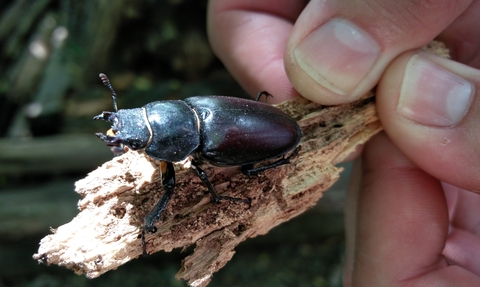
Magical Minibeasts
Seek out and capture unsuspecting invertebrates in the various habitats at our reserves.
Young explorers will set off into the ‘wild’ of our nature reserves to seek out and capture a variety of minibeasts in a range of habitats and micro-habitats: hunting under log piles, in rockeries, amongst compost and in our long grass meadows. After observing the creatures in their natural habitats, children will be able to take their finds back to the classroom and view them under the microscope before releasing them back into the wild.
Our tutors are passionate and knowledgeable about the invertebrates found on site and will help facilitate discussions with your pupils around habitats, adaptations, food chains and much more.
- Venue: Available at Tyland Barn Nature Park and Sevenoaks Wildlife Reserve.
- Setting: Outdoors and covered teaching shelter.
- Time: 50 minutes – 90 minutes (depending on number of groups per visit).
EYFS/Key Stage 1?
Why not add on an Explore a Story workshop to make this session more engaging? Explore a range of stories to engage, inspire and excite younger nature explorers, including The Very Hungry Caterpillar, Tadpole’s Promise and many more.
National Curriculum Links
Our Minibeast session can aid in the learning of the following Key Stage 1 and 2 Science curriculum links and can also be adapted for Key Stage 3 and 4 learners. If there are specific curriculum objectives you are hoping to achieve during your visit, please contact our education team in advance on education@kentwildlife.org.uk or talk to one of our tutors on the day.
Year 1: Animals, including humans
- identify and name a variety of common animals including fish, amphibians, reptiles, birds and mammals
- identify and name a variety of common animals that are carnivores, herbivores and omnivores
Year 2: Living things and their habitats
- explore and compare the differences between things that are living, dead, and things that have never been alive
- identify that most living things live in habitats to which they are suited and describe how different habitats provide for the basic needs of different kinds of animals and plants, and how they depend on each other
- identify and name a variety of plants and animals in their habitats, including microhabitats
- describe how animals obtain their food from plants and other animals, using the idea of a simple food chain, and identify and name different sources of food.
Year 2: Animals, including humans
- notice that animals, including humans, have offspring which grow into adults
- find out about and describe the basic needs of animals, including humans, for survival (water, food and air)
Year 3: Animals, including humans
- identify that animals, including humans, need the right types and amount of nutrition, and that they cannot make their own food; they get nutrition from what they eat
Year 4: Living things and their habitats
- recognise that living things can be grouped in a variety of ways
- explore and use classification keys to help group, identify and name a variety of living things in their local and wider environment
- recognise that environments can change and that this can sometimes pose dangers to living things.
Year 4: Animals, including humans
- construct and interpret a variety of food chains, identifying producers, predators and prey.
Year 5: Living things and their habitats
- describe the differences in the life cycles of a mammal, an amphibian, an insect and a bird
- describe the life process of reproduction in some plants and animals.
Year 6: Living things and their habitats
- describe how living things are classified into broad groups according to common observable characteristics and based on similarities and differences, including microorganisms, plants and animals
- give reasons for classifying plants and animals based on specific characteristics.
Year 6: Evolution and inheritance
- identify how animals and plants are adapted to suit their environment in different ways and that adaptation may lead to evolution.
